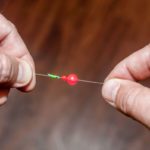
Slip corks make changing depth easy
I grew up bream fishing, and we caught a lot of fish using cane poles. And as I aged, I pretty much kept to the same approach, moving to telescopic graphite jig poles.
And then I decided one day to try a slip cork rig — and it changed my entire bream-fishing world.
Today, whenever I hit the water to catch some panfish, you’ll see me with an ultralight spinning rig with a slip cork so I can make precision casts without having to get right on top of my target.
And if I need to change the depth at which my cricket (and it’s almost always a cricket threaded onto my hook), all I have to do is slide the cork stopper up or down the line.
The biggest advantage is that the line can be reeled all the way in, so casts can be made without having a dozen inches of line dangling and flopping around.
It’s quick. It’s easy. And it catches a ton of fish.
Ingredients for the rig are:
• Bobber stoppers — I prefer the type made with strings and plastic tubing, like the Rod-n-Bobb’s version sold at Academy.
• Plastic beads — Normally very small beads are included with your bobber stoppers, but you also will need larger beads that won’t slide into your corks.
• Sliding corks — You know, the corks with the little plastic peg. I like the small, conical Styrofoam corks. The pegs can be removed and discarded.
• Small jigs — I prefer a 1/16-ounce jig, because you won’t have to worry about the weight sliding around. But you could use a worm hook and BB weights.
Here’s how to rig it up.
1) Slide your line through the bobber stopper’s plastic tubing, leaving you plenty of tag line to work with.
2) Slip the tubing out of the bobber stopper and off the end of the line (some versions have tubing that is slotted so it just slips right off the line).
3) Pull the ends of the bobber stopper string in opposite directions, cinching it down tightly and trim the tag ends. I’ve found that the knot can loosen if the string isn’t pulled very tight — and once that happens, you will never get the bobber stopper tied again, and you’ll have to rerig.
4) Slide one of the small bobber stopper beads on the line, followed by one of the larger beads.
5) Add the cork to the line, ensuring that the colored portion of the cork is pointed up the line (so you can see it when it floats).
6) Add another large bead under the cork.
7) Tie on your jig.
Now you’re ready to go, and the depth at which the jig and bait will suspend can be quickly changed by simply sliding the bobber stopper up and down the line.
Watch the vid!
You can watch a vid of how to set up a slip-cork rig by going to www.LouisianaSportsman.com/how-to-tie-slip-cork.










